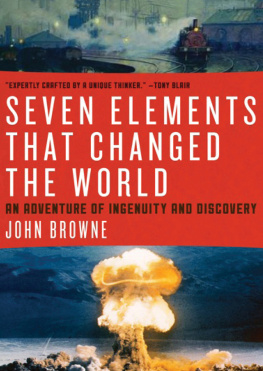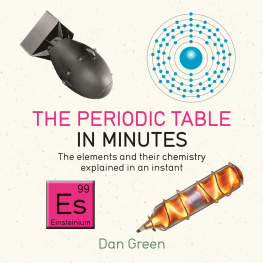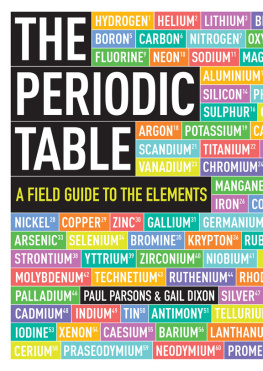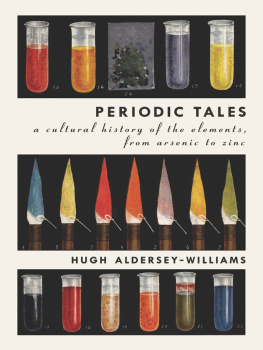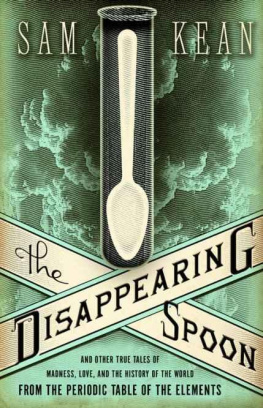Copyright 2010 by Sam Kean
Reading group guide copyright 2011 by Sam Kean and Little, Brown and Company
All rights reserved. Except as permitted under the U.S. Copyright Act of 1976, no part of this publication may be reproduced, distributed, or transmitted in any form or by any means, or stored in a database or retrieval system, without the prior written permission of the publisher.
Back Bay Books / Little, Brown and Company
Hachette Book Group
237 Park Avenue, New York, NY 10017
Visit our website at www.HachetteBookGroup.com
www.twitter.com/littlebrown
Second eBook Edition: June 2011
Back Bay Books is an imprint of Little, Brown and Company. The Back Bay Books name and logo are trademarks of Hachette Book Group, Inc.
The publisher is not responsible for websites (or their content) that are not owned by the publisher.
ISBN: 978-0-316-08908-1
Irresistible. The Disappearing Spoon reveals history, passions, madness, and the all-out drama of our lives. Kean is brimming with puckish wit, and his love for the elements is downright infectious. Sure to dazzle any reader. Kean finds amazing stories attached to every element of the table. His writing sparks like small shocks. He gives science a whiz-bang verve so that every page becomes one you cannot wait to turn just to see what hes going to reveal next. Keans book is so rambunctious and so much fun, youll find yourself wanting to grab someone just to share the tidbits. But the alchemy of this book is the way Kean makes you see and experience and appreciate the world differently, with a real sense of wonder and a joy of discovery, that is downright elemental.
Caroline Leavitt, Boston Globe
The best science writers bring an enthusiasm for the material that infects even those of us who wouldnt usually give a flying photon. Kean unpacks the periodic tables bag of tricks with such aplomb and fascination that material normally as heavy as lead transmutes into gold. With the anecdotal flourishes of Oliver Sacks and the populist accessibility of Malcolm Gladwell, Kean makes even the most abstract concepts graspable for armchair scientists. His keen sense of humor is a particular pleasure. Kean succeeds in giving us the cold hard facts, both human and chemical, behind the astounding phenomena without sacrificing any of the wondera trait vital to any science writer worth his NaCl.
Keith Staskiewicz, Entertainment Weekly
Really excellent. I cant recommend The Disappearing Spoon highly enough. The stories associated with the various elements and experiments designed to test one hypothesis or another make great reading. Get the book.
Jon Carroll, San Francisco Chronicle
Sam Kean is a teacher who enlivens even the most tedious subjects by relating material to everyday life in everyday language and who exhumes juicy back stories about experiments and the people performing them. The Disappearing Spoon has undeniably sharp science teeth. Its information-packed chapters are infused with ebullience. Kean jumps gleefully from one story to the next, confident in exactly how all the details fit. His conversational prose sizzles with pop culture references and he provides surprisingly informal analogies. Keans palpable enthusiasm and the thrill of knowledge and invention the book imparts can infect even the most right-brained reader.
Christine Thomas, Miami Herald
Sam Kean portrays the periodic table using a cast of characters whose stories illustrate our interactions with the physical world. By weaving handfuls of tales into loose themes in each chapter, he leaves no corner of the table untouched. All readers will learn something. Kean writes with energy and pace.
Philip Ball, Nature
Ebullient. Kean turns The Disappearing Spoon into a nonstop parade of lively science stories. A timely conversation piece.
Janet Maslin, New York Times
Kean does a remarkable job of keeping his book about the magic and horrors of chemical science jargon-free. An ambitious but user-friendly book about the weird and wonderful world of chemical elements.
Dan Falk, Associated Press
A fresh look at the elements that make up our world. The book is peppered with anecdotes about the elements application and the surprisingly colorful scientists who were involved in their discovery and development. Leaving no substance in the table unexplored, Kean provides interesting and sometimes startling facts about the building blocks of the universe.
Daily Beast
Weve discovered 112 formally recognized elements, and every last one has a storysometimes hilarious, sometimes frighteningto tell. The Disappearing Spoon recounts the discovery and use of every last element, introducing us to some of sciences most colorful and eccentric figures. This isnt just about the lighter side of the periodic table, as Kean also uses these anecdotes to help explain just why elements behave the way that they do.
Alasdair Wilkins, io9.com
Thoughtful, engrossing. Whether a scientist, historian, or gossip queen, there is something for almost every kind of reader here.
Kate Quealy-Gainer, Minneapolis Star Tribune
Fascinating. The book is written in such a way that readers wont need to bone up on their chemistry to understand the science. And those who do remember their chem class days wont be bored since the book is filled with so many stories from such a range of areas of history, from war to biology to literature.
Sarah Zielinski, Smithsonian
That mystifying chart on the wall in high school chem class, decoded.
Los Angeles Times
The book is strong, a simple, well-written collection of comic, tragic, and just plain strange stories starring the members of the periodic table.
Samantha Nelson, The Onions A.V. Club
Sam Kean has done something remarkable: hes made some highly technical science accessible, placed well-known and lesser-known discoveries in the context of history, and made reading about the lives of the men and women inside the lab coats enjoyable. The stories are fascinating. Keans a great yarn spinner.
Andy Alford, Austin American-Statesman
Like all good science writers, Kean is fired by boundless curiosity and gee-whiz wonder, not just at the physical universe but also at humankinds untiring attempts to figure it out.
Alison Gillmor, Winnipeg Free Press
An engaging tour of the elements. Kean mostly revels in the wonderful weirdness of the elements themselves.
Jennifer Schuessler, New York Times Book Review
A parade of entertaining anecdotes about scientists (mad and otherwise). With a constant flow of fun facts bubbling to the surface, Kean writes with wit, flair, and authority.
Publishers Weekly
Quirky, thoughtful, and thorough. If your most recent glance at the periodic table was in a classroom long ago, have no fear, this book is threaded with plots more often found in love stories or thrillers than in chemistry books, and Keans enthusiasm and wit carry the reader through spells of heavy lifting. Even hard-core chemists will undoubtedly learn something new.
Rachel Ehrenberg, ScienceNews
Few of us would ever associate the periodic table of the elements with high intrigue. But as Sam Kean details, behind those lettered boxes lies a sordid past.
Fenella Saunders, American Scientist
Fascinating. Kean writes in a whimsical yet easy-to-read style. Highly recommended for public libraries and for amateur, high school, and undergraduate scientists wishing to be informed as well as entertained.


